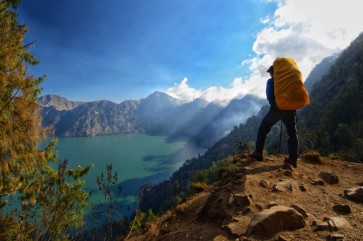Popular Reads
Top Results
Can't find what you're looking for?
View all search resultsPopular Reads
Top Results
Can't find what you're looking for?
View all search results‘Babad Ngalor-Ngidul’ - A dialogue between north & south
(Elizabeth Inandiak)For French author Elizabeth D
Change text size
Gift Premium Articles
to Anyone
(Elizabeth Inandiak)
For French author Elizabeth D. Inandiak, the Javanese term ‘ngalor-ngidul’, which means without clear direction, does not always mean pointlessness.
Back in 2010, the late spiritual guardian of Mount Merapi in Yogyakarta, Ki Surakso Hargo who was better known as Mbah Maridjan, refused to flee when the authorities raised the volcano’s status to the highest alert.
The volcano reportedly “asked” for a black goat offering a day after the Volcanology and Geological Hazard Mitigation Center raised its status to the highest alert. Yogyakarta Palace then sent the goat to Kinahrejo hamlet, located some 4 kilometers from the mountain’s raging crater, but it had not arrived by the time sirens began sounding at 5:37 p.m. on Oct. 26, 2010.
Mbah Maridjan declined to leave, saying the hamlet and the volcano were his home. “If it’s time for an evacuation, people must be evacuated. Please, don’t follow a stupid man who never went to school like me,” he said as quoted in Elizabeth D. Inandiak’s non-fiction book Babad Ngalor-Ngidul (The Chronicle of Ngalor Ngidul).
In the book, Inandiak narrates the tension before the mountain spewed out hot clouds, locally known as wedhus gembel, a Javanese expression for sheep-shaped pyroclastic clouds.
“He [Maridjan] was a kind and loving man,” the 57-year-old grandmother said during the recent launch of her book at the French Institute in Jakarta.
Inandiak, who has lived in Indonesia for more than 25 years, said Mbah Maridjan had regarded her as a daughter.
She also shares the ups and downs of their relationship in the 212-page Babad Ngalor-Ngidul, which took her three years to complete.
She recalled that she first met Maridjan in January 1995 when she joined a Labuhan ceremony led by him after the volcano erupted in late 1994 killing more than 60 people.
With her friend who worked as a rain shaman, she often visited Maridhan’s home at Kinahrejo hamlet. One day, he showed her two sacred sites — namely Batu Gajah (Elephant Stone) and Beringin Putih (White Banyan) on the slopes of Merapi.
The sites surprised her. She believed they were a tangible form of a fairytale, entitled Pohon Gajah (Elephant Tree), which she wrote in June 1991 to celebrate the birth of her daughter.
“Every time I see a banyan tree in Yogyakarta, I always feel that it is an elephant,” she said.
Pohon Gajah tells of the friendship between sailor Barata and an elephant. After discovering that elephant hunters are chasing them, he changes his friend into a banyan tree by using a mantra in a bid to divert their attention. Afterward, he leaves the banyan on a mountain slope.
She said the 2010 eruption not only claimed the lives of at least 35 people, including Maridjan, but also broke Batu Gajah and Beringin Putih.
Inandiak, who lives in Pajangan hamlet, located some 20 kilometers from the peak of Mount Merapi, recalled that ash clouds covered the sky with great claps of thunder, rattling the windows of her Javanese traditional-style joglo house, which she built with her Indonesian husband.
Following the eruption, she went to Kinahrejo to help clear up the debris. She then found a primbon book (a traditional Javanese horoscope) and brought it home.
“The primbon book has become an heirloom that motivated me to write Babad Ngalor-Ngidul,” she said. “There was a ‘sound’ that asked me to write.”
Although the eruption is regarded as a natural disaster, Inandiak believes it is a form of a dialog between Mount Merapi in the north, lor in Javanese, and the South Sea in the south, kidul in Javanese.
“At that time, the only person who could understand the dialog [between Mount Merapi and the South Sea] was Mrs. Pujowijono, not Mbah Maridjan,” she said, referring to the woman who provided offerings for Javanese rituals on the slopes of Merapi.
The book, she said, was her tribute to Mrs. Pujo Wijono, the owner of the primbon book that she found. Like Maridjan, she died after suffering serious burns during the eruption.
Inandiak then named her book Babad Ngalor-Ngidul, which also featured the paintings of visual artist Heri Dono. They have collaborated since 1989.
From him, she first heard the term ngalor ngidul when they were planning to hold an art exhibition in Singapore to sell his paintings in a bid to raise money to help the Kinahrejo people.
Inandiak said that being honest was the main challenge in the writing of Babad Ngalor-Ngidul because she had to narrate difficult moments, including the time when Maridjan had somehow lost direction — very kind but less wise, probably influenced by various people.
“Kindness and wisdom are supposed to be balanced. But, that’s difficult to achieve,” she says. “This book aims to appease the anger of many of Maridjan’s friends [who felt] as if he was the one responsible for the eruption.”
Editor Christina M. Udiani of Kepustakaan Populer Gramedia (KPG), which published the book, praised Inandiak’s work. “Elizabeth has a writing style that is different from other writers. She really pays attention to words that she chooses and she has written the book like she was writing poetry.”
The publishing company also published Inandiak’s book Centhini: Kekasih Yang Tersembunyi (Centhini: Hidden Lover) in 2008. She was inspired by the thesis Critique et Consideration du Livre Centhini (Criticism and Thoughts of the Centhini Book), written by Mohamad Rasjidi, Indonesia’s first religious affairs minister, after he completed his Ph.D. in the Sorbonne in Paris.
On Sept. 2, 2014, the French government honored Inandiak with the Chevalier de la Légion d’Honneur award for her dedication to literature and her contribution to strengthening French and Indonesia relations.
Inandiak, who translated Ayu Utami’s novel Saman into French in 2008, said she plans to translate the works of philosopher and writer Raden Ngabehi Ronggowarsito of Surakarta’s Kasunan Palace in Central Java.
“As a poet, I feel I have a responsibility to introduce Java’s greatest poet to the French people,” she said of Ronggowarsito, whom she regards as the “Victor Hugo of Indonesia”.
— Photos by A. Kurniawan Ulung










